Sony
Sony large sensor cams
April/06/12 12:56 Filed in: Video Cameras
The Large Sensor Camera that I have pixel envy for currently is the Sony F3:

http://pro.sony.com/bbsc/ssr/show-highend/resource.solutions.bbsccms-assets-show-highend-pmwf3.shtml
They have a much cheaper version (NEX-FS 100U) that is really popular due to having the 35mm-ish-size sensor, but it is hobbled in a few ways from a video pro's perspective:
http://pro.sony.com/bbsc/ssr/micro-nxcamsite/resource.latest.bbsccms-assets-micro-nxcam-solutions-nexfs100ulanding
But they've just announced, pre-NAB the updated version which looks very cool (addresses a lot of the issues, plus does super slo-mo and will do full 4k with a future upgrade) the 700U:
http://www.engadget.com/2012/04/02/sony-nex-fs700-cinema-camera/
So the F3 costs too much but is awesome, the 100U is way cheaper but not something I would really want to own, but I'll be really interested to see exactly what and how much the 700 turns out to be - supposed to be under $10k, but I'm not sure if that's with or without lens.
I was kind of hoping for a little brother of the F3 rather than a big brother of the FS100, but I imagine they're selling a lot more 100's and they're cheaper to produce. I still think there should be a PMW-EX5 or something that updates the EX1 and 3 to a large sensor. But that's probably not possible in that camera's architecture - again, not sure, just wishful thinking. This 700 could mostly be it. Plus the path to 4k inspires confidence in its future viability.
I broke down and pimped my EX1 with a matte box, rails and focus knob from Shoot35. Nice bang for the buck vs. the major players. So now there's a place to mount the Samurai and 7" monitor.

http://pro.sony.com/bbsc/ssr/show-highend/resource.solutions.bbsccms-assets-show-highend-pmwf3.shtml
They have a much cheaper version (NEX-FS 100U) that is really popular due to having the 35mm-ish-size sensor, but it is hobbled in a few ways from a video pro's perspective:
http://pro.sony.com/bbsc/ssr/micro-nxcamsite/resource.latest.bbsccms-assets-micro-nxcam-solutions-nexfs100ulanding
But they've just announced, pre-NAB the updated version which looks very cool (addresses a lot of the issues, plus does super slo-mo and will do full 4k with a future upgrade) the 700U:
http://www.engadget.com/2012/04/02/sony-nex-fs700-cinema-camera/
So the F3 costs too much but is awesome, the 100U is way cheaper but not something I would really want to own, but I'll be really interested to see exactly what and how much the 700 turns out to be - supposed to be under $10k, but I'm not sure if that's with or without lens.
I was kind of hoping for a little brother of the F3 rather than a big brother of the FS100, but I imagine they're selling a lot more 100's and they're cheaper to produce. I still think there should be a PMW-EX5 or something that updates the EX1 and 3 to a large sensor. But that's probably not possible in that camera's architecture - again, not sure, just wishful thinking. This 700 could mostly be it. Plus the path to 4k inspires confidence in its future viability.
I broke down and pimped my EX1 with a matte box, rails and focus knob from Shoot35. Nice bang for the buck vs. the major players. So now there's a place to mount the Samurai and 7" monitor.
Comments
Sony PMW 100
June/19/12 12:52 Filed in: Video Cameras
It's a spiff unit - but a pretty small chip.
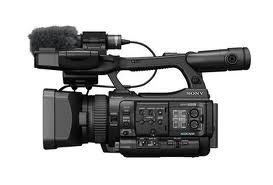
Might be a good replacement for the Panasonic AX-100 - level stuff. Would like to go HD with all clients, but not for free!
One thing to pay attention to on these new cameras is that some are 3-chip and some are 1. Traditionally that was how you could tell a pro camera from a consumer. Like the EX1 is (3) 1/2" chips. Stuff like the Sony FS100/700/F3, etc. are competing with large DSLRs, so they are 1 LARGE chip. The PMW 100 is (1) slightly-larger-than ⅓” chip (1/2.9"), so I dunno how that will perform. Certainly they're making great strides in that area. And the onboard 50Mbps XDCAM recording capability is cool - wouldn't necessarily need an outboard recorder. It'll be interesting to see some footage from it.

Might be a good replacement for the Panasonic AX-100 - level stuff. Would like to go HD with all clients, but not for free!
One thing to pay attention to on these new cameras is that some are 3-chip and some are 1. Traditionally that was how you could tell a pro camera from a consumer. Like the EX1 is (3) 1/2" chips. Stuff like the Sony FS100/700/F3, etc. are competing with large DSLRs, so they are 1 LARGE chip. The PMW 100 is (1) slightly-larger-than ⅓” chip (1/2.9"), so I dunno how that will perform. Certainly they're making great strides in that area. And the onboard 50Mbps XDCAM recording capability is cool - wouldn't necessarily need an outboard recorder. It'll be interesting to see some footage from it.
The new Sony PMW 200
June/20/12 12:50 Filed in: Video Cameras
It’s pretty bitchin’
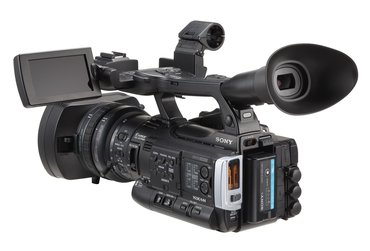
People have been complaining that they aren't putting pro codecs in these awesome cameras they're coming out with - like the FS100 and 700. Why a so-so AVCHD onboard codec, and not an established pro codec like XDCAM? Even the EX1 and EX3 are XDCAM EX 4:2:0 at 35 Mbps. This little unit is XDCAM 4:2:2 at 50 Mbps! Cool!
Again, though, I would like to see what this (new, I think) sensor looks like. Assuming it doesn't suck, the camera looks like a sure-thing-type good investment. TC in/out, Genlock in/out, SDI out…. it will likely get a lot of use in multi cam shoots due to the connectivity alone.
The big question is, "Where is the PMW-EX5?". Many expect that to be the next thing to drop.

People have been complaining that they aren't putting pro codecs in these awesome cameras they're coming out with - like the FS100 and 700. Why a so-so AVCHD onboard codec, and not an established pro codec like XDCAM? Even the EX1 and EX3 are XDCAM EX 4:2:0 at 35 Mbps. This little unit is XDCAM 4:2:2 at 50 Mbps! Cool!
Again, though, I would like to see what this (new, I think) sensor looks like. Assuming it doesn't suck, the camera looks like a sure-thing-type good investment. TC in/out, Genlock in/out, SDI out…. it will likely get a lot of use in multi cam shoots due to the connectivity alone.
The big question is, "Where is the PMW-EX5?". Many expect that to be the next thing to drop.
Sony FS100
August/31/12 12:46 Filed in: Video Cameras
This is some interesting footage.
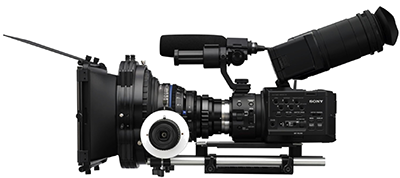
http://nofilmschool.com/2012/08/sony-fs100-vs-blackmagic-cinema-camera-low-light-showdown/?utm_source=feedburner&utm_medium=feed&utm_campaign=Feed%3A+nofilmschool+%28NoFilmSchool%29
Unfortunately, it reminds me somewhat of the first Zacuto Shootout, where they set up a really difficult-to-image scene so you could see where the cameras/codecs broke. It doesn't tell you a whole lot more than that. In this situation, they both look pretty bad - except that you can see that RAW has a lot more latitude than the other codecs (no surprise there).
Based on this and other footage I've seen from the FS100, I would want to record to an external recorder. I still haven't seen anything really great from it even though it has a big sensor. But it seems like people are always posting torture tests or bad grades, and we're supposed to figure out what the cameras can do from that? That was what was so interesting about the recent Shootout, where they let people who work with the various cameras every day do what is necessary to make it look good. And they pretty much ALL looked good.
So it seems to me the biggest factors when buying a camera now are: What's it REALLY going to cost you to do the workflow the camera sets you up for, and does the camera have the functionality you need for working with it all day to do the type of shooting you do?
I would not want to give up all the standard, pro-camera type controls you get on a unit from one of the major manufacturers for the promise of potentially better images. Functionality is a big deal. As an example, a (former Oprah) guy that works for me on occasion, who does a lot of run-n-gun is bummed that all these cool cameras coming out are not standard broadcast-shoulder-mount style cameras. He just can't see having to put together some sort of rig just to be able to use it on his shoulder - and then he probably couldn't one-hand it!
Most of the new cameras are intended for cinema-style shooting. They are large-sensors to compete with DSLRs. That's why it's nice to see stuff like the PMW-200. Though it's not like the Sonys of the world have stopped making old-school cameras. It's that the technology in the new cameras is not immediately showing up in a familiar form.

http://nofilmschool.com/2012/08/sony-fs100-vs-blackmagic-cinema-camera-low-light-showdown/?utm_source=feedburner&utm_medium=feed&utm_campaign=Feed%3A+nofilmschool+%28NoFilmSchool%29
Unfortunately, it reminds me somewhat of the first Zacuto Shootout, where they set up a really difficult-to-image scene so you could see where the cameras/codecs broke. It doesn't tell you a whole lot more than that. In this situation, they both look pretty bad - except that you can see that RAW has a lot more latitude than the other codecs (no surprise there).
Based on this and other footage I've seen from the FS100, I would want to record to an external recorder. I still haven't seen anything really great from it even though it has a big sensor. But it seems like people are always posting torture tests or bad grades, and we're supposed to figure out what the cameras can do from that? That was what was so interesting about the recent Shootout, where they let people who work with the various cameras every day do what is necessary to make it look good. And they pretty much ALL looked good.
So it seems to me the biggest factors when buying a camera now are: What's it REALLY going to cost you to do the workflow the camera sets you up for, and does the camera have the functionality you need for working with it all day to do the type of shooting you do?
I would not want to give up all the standard, pro-camera type controls you get on a unit from one of the major manufacturers for the promise of potentially better images. Functionality is a big deal. As an example, a (former Oprah) guy that works for me on occasion, who does a lot of run-n-gun is bummed that all these cool cameras coming out are not standard broadcast-shoulder-mount style cameras. He just can't see having to put together some sort of rig just to be able to use it on his shoulder - and then he probably couldn't one-hand it!
Most of the new cameras are intended for cinema-style shooting. They are large-sensors to compete with DSLRs. That's why it's nice to see stuff like the PMW-200. Though it's not like the Sonys of the world have stopped making old-school cameras. It's that the technology in the new cameras is not immediately showing up in a familiar form.
Sony PMW 200
September/01/12 12:44 Filed in: Video Cameras
Some pros and cons on the new Sony camera

$7,800 list price. The EX-1 listed for around that but sold for $6,500. I think the earlier numbers were guesstimates of the street price.
Yeah - not exactly cheap. B&H is listing it for $6,300. Plus cards and batts and etc. But it's the same price as the EX-1 was back when I bought it, so not terrible. And you don't have to buy a lens, and can likely get by without an external recorder.
The only thing that's a bit of a bummer (for me, if I was to consider it as a replacement for my EX-1) is that it is essentially the same chips and lens as the EX-1 with some added features and better on-board recording. So it's not like I would be getting better quality from the main guts of the thing. Yes, the recordings going to the cards would be better, but with the Samurai, I am already getting 4:2:2 AND even higher-bitrate ProRes, so I can technically make better recordings with my existing camera.
If I didn't already own the EX-1, though, I would definitely put it high on the consideration list.
The integration with 'pro' XDCAM stuff will be big for a lot of folks. It should make it easier to do dailies and archives to BD, which I would really like. I'm finding myself wishing I had an easy way to burn discs of the raw footage I shoot on the thing. I have already lost some original footage by mistakenly erasing the wrong hard drive (the one with the ONLY backup on it - AFTER I had re-used the cards).
So just having it on hard drives still makes me nervous, even if I have two copies. After a year or so, you start looking back through the HDs and going, "hey there's a bunch of space on this one, what if I moved this over here, blah blah…" and pretty soon you don't know what you've got or where it is. Clearly I need better data management skills. If it's burned to a shiny disc though, it's locked down for at least a decade - it's more like having a tape master backup. I think a lot of pro environments are still using DLT tape, but unless that has changed significantly, it takes forever. I guess you just leave it running overnight.

$7,800 list price. The EX-1 listed for around that but sold for $6,500. I think the earlier numbers were guesstimates of the street price.
Yeah - not exactly cheap. B&H is listing it for $6,300. Plus cards and batts and etc. But it's the same price as the EX-1 was back when I bought it, so not terrible. And you don't have to buy a lens, and can likely get by without an external recorder.
The only thing that's a bit of a bummer (for me, if I was to consider it as a replacement for my EX-1) is that it is essentially the same chips and lens as the EX-1 with some added features and better on-board recording. So it's not like I would be getting better quality from the main guts of the thing. Yes, the recordings going to the cards would be better, but with the Samurai, I am already getting 4:2:2 AND even higher-bitrate ProRes, so I can technically make better recordings with my existing camera.
If I didn't already own the EX-1, though, I would definitely put it high on the consideration list.
The integration with 'pro' XDCAM stuff will be big for a lot of folks. It should make it easier to do dailies and archives to BD, which I would really like. I'm finding myself wishing I had an easy way to burn discs of the raw footage I shoot on the thing. I have already lost some original footage by mistakenly erasing the wrong hard drive (the one with the ONLY backup on it - AFTER I had re-used the cards).
So just having it on hard drives still makes me nervous, even if I have two copies. After a year or so, you start looking back through the HDs and going, "hey there's a bunch of space on this one, what if I moved this over here, blah blah…" and pretty soon you don't know what you've got or where it is. Clearly I need better data management skills. If it's burned to a shiny disc though, it's locked down for at least a decade - it's more like having a tape master backup. I think a lot of pro environments are still using DLT tape, but unless that has changed significantly, it takes forever. I guess you just leave it running overnight.
Still cameras for video
January/30/13 12:34 Filed in: Video Cameras
My thought is still to use a video camera for video. Too many hassles and compromises with using still cameras for video.
It's cool if you are a still photographer who has a lot invested in lenses and you want to get into video, but if you're starting from scratch, the extra stuff you need will end up driving the cost up to the level of a dedicated video camera, and then it's not an integrated system.
This is the big problem with this whole trend toward what I might call 'mini-Cine' rigs - there's a lot of stuff and expense aside from the camera head itself. Which is why for most of us, a PMW-type camera is ideal. I mean, unless you really have a NEED for the interchangeable lenses that you get paid for (and will mostly be working cine-style).
It's cool if you are a still photographer who has a lot invested in lenses and you want to get into video, but if you're starting from scratch, the extra stuff you need will end up driving the cost up to the level of a dedicated video camera, and then it's not an integrated system.
This is the big problem with this whole trend toward what I might call 'mini-Cine' rigs - there's a lot of stuff and expense aside from the camera head itself. Which is why for most of us, a PMW-type camera is ideal. I mean, unless you really have a NEED for the interchangeable lenses that you get paid for (and will mostly be working cine-style).
Sony PMW 300
June/24/13 12:31 Filed in: Video Cameras
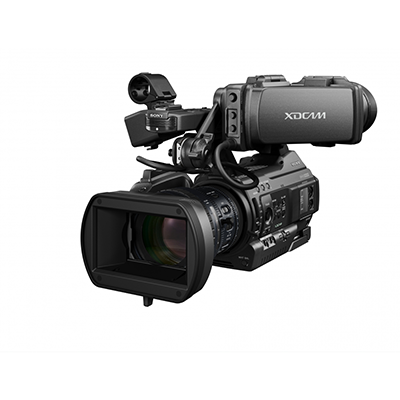
I have a feeling that the new Sony PMW-300:
1) It should be a good solid camera that may have a useful lifespan
2) It's too little too late in some ways
The improvements over the existing EX cameras are incremental. I had frankly hoped for some sort of merging of the EX's with the Fs700 or something along those lines, but I guess the EX-type camera is stuck being a half-inch, three-sensor deal. I've been meaning to do some research on the tradeoffs between 3 chip and the big single chip cameras.
It certainly is nice to have 4:2:2 onboard recording, since regular XDCAM EX is getting long in the tooth, but it's not a huge difference, and I would still use it as simultaneous-record backup. Once you go direct to ProRes, it's pretty hard to go back unless you have to. But for those shooting handheld, and those shooting for Euro broadcast, it certainly makes sense.
The big question mark in my mind is, what will the implementation of the future XAVC codec upgrade be? They are using that codec now in the F5 and F55. Since it already will have 422 50Mbps recording, I'm assuming it will be the 444/ up to 300Mbps flavor. That will likely require buying all new high speed cards to handle the data rate. Plus the rest of the workflow that goes with it - which admittedly is less onerous than much of the 4k & RAW crap that's going on at the moment.
Speaking of which, I've been reading a lot the press and blogs about 4k and RAW, and I really don't see the need for either for a vast majority of shooters - unless you have a client who wants to pay for it, or you want it for your own project. You pay a big price in terms of data rate, cards, hard drives, editing, money, etc. for differences most people can't see. The compressed codecs are just too good for the most part. Hell, I'm still shooting all 720p60, and my clients think it looks awesome. Depends on what you're used to.
The other thing I wonder about XAVC is, being another implementation of H.264, what is its future once H.265 hits the real world? The codec (aka HEVC - high efficiency video codec) has been officially released, and so it should just be a matter of time before it is implemented in cameras and such. H.264 is 10 years old now. H.265 is half the data rate for the same quality (allegedly).
Canon C100
June/26/13 12:16 Filed in: Video Cameras
This thing is starting to get more love out there.
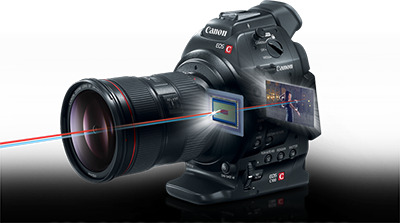
http://www.bhphotovideo.com/bnh/controller/home?O=NavBar&A=getItemDetail&Q=&sku=889545&is=REG&si=rev#costumerReview
Pretty cool, but has its drawbacks. Read the top best & worst reviews. The worst one sums up the issues well. Pretty cool though. I just continue to have the feeling (hope?) that somebody is going to come out with a mashup of the FS700 and this thing, or something like I thought the new EX camera would be - a combo of the usability and functionality of the EX cameras, but with the big sensor and slo-mo of the FS700. I'm guessing/hoping within a year...

http://www.bhphotovideo.com/bnh/controller/home?O=NavBar&A=getItemDetail&Q=&sku=889545&is=REG&si=rev#costumerReview
Pretty cool, but has its drawbacks. Read the top best & worst reviews. The worst one sums up the issues well. Pretty cool though. I just continue to have the feeling (hope?) that somebody is going to come out with a mashup of the FS700 and this thing, or something like I thought the new EX camera would be - a combo of the usability and functionality of the EX cameras, but with the big sensor and slo-mo of the FS700. I'm guessing/hoping within a year...
4K Camera News
September/24/13 12:08 Filed in: Video Cameras
The new Sony 4k PXW-Z100 and FDR-AX1 4k cameras
Here's a clip from Alister Chapman at IBC about the new Sony 4k PXW-Z100 camera - and at about 2:30 they talk about why you would use the PMW-200 over this jobber!
http://www.newsshooter.com/2013/09/13/ibc-2013-sony-pxw-z100-and-fdr-ax1-4k-cameras/
So don't feel so bad! You probably have a better camera! Unless you have client clamoring for 4k…..
But seriously, 4k on a less-than-half -inch chip!? I notice all the demo shots are wide, because if they shot close you would see how video-y it will look. Still, pretty cool.
What I have been imagining is a camera like the EX3 with (3) 4k chips, or one big one. Been looking again at the FS-700, as they have enabled the 4K capability on that, and it looks pretty. Super 35mm sensor as in the F5 and F55.
A quick way to explain the Bayer sensor deal (almost all of these large single-chip cameras nowadays are Bayer sensors) is:
"One thing to remember is that because of the nature of a Bayer sensor you need the sensor to have a higher pixel count than the final desired resolution. Typically you want at least 30% more pixels than your target resolution. As a minimum for good 1080 you want around 2.5K-2.7K pixels."
That's also from Alister Chapman, a cameraman/blogger who knows his stuff. So when the REDs of the world are bragging on their latest mega-mega-pixel sensor, you have to ask, "how many REAL pixels is that?"
Here's a clip from Alister Chapman at IBC about the new Sony 4k PXW-Z100 camera - and at about 2:30 they talk about why you would use the PMW-200 over this jobber!
http://www.newsshooter.com/2013/09/13/ibc-2013-sony-pxw-z100-and-fdr-ax1-4k-cameras/
So don't feel so bad! You probably have a better camera! Unless you have client clamoring for 4k…..
But seriously, 4k on a less-than-half -inch chip!? I notice all the demo shots are wide, because if they shot close you would see how video-y it will look. Still, pretty cool.
What I have been imagining is a camera like the EX3 with (3) 4k chips, or one big one. Been looking again at the FS-700, as they have enabled the 4K capability on that, and it looks pretty. Super 35mm sensor as in the F5 and F55.
A quick way to explain the Bayer sensor deal (almost all of these large single-chip cameras nowadays are Bayer sensors) is:
"One thing to remember is that because of the nature of a Bayer sensor you need the sensor to have a higher pixel count than the final desired resolution. Typically you want at least 30% more pixels than your target resolution. As a minimum for good 1080 you want around 2.5K-2.7K pixels."
That's also from Alister Chapman, a cameraman/blogger who knows his stuff. So when the REDs of the world are bragging on their latest mega-mega-pixel sensor, you have to ask, "how many REAL pixels is that?"
Arri Amira - We Don' Need No Stinking 4K!
September/19/13 12:02 Filed in: Video Cameras
Yeah - no way I could afford it either - but it's pretty!
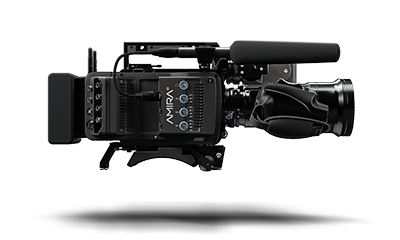
http://www.arri.com/amira/
The major thing is THEY BUILT A CAMERA THAT YOU CAN PICK UP AND SHOOT WITH like normal cams of yore! Did you see the adjustable shoulder rest and eyepiece?! Don't need an effing cage with crap bolted all over it! AND FULL QUALITY 200fps! Yowza indeed.
They have some over-the-top grading on the showreel stuff, but I generally like the look of Alexa-stuff over RED. Haven't ever really cared for the look of a lot RED footage - it seems to have a “hardness” that doesn’t appeal to me. Still like the look of Sony stuff though - guess I'm a traditionalist. They get slammed a lot for being excessively red-tinted by people who like the green-leaning look of Ikegami (if they're old like some of us) or the "moody" green grades you see in movies these days.
Still hope to one day either be able to afford (have jobs for) an F3, or maybe an FS-700. I keep thinking (thought the new EX-3 upgrade, the PMW-300 was going to be it - but it ain't) they're going to combine an EX-style camera with an F3-type sensor and such.
Good article on trying to make sense of sensor size and crop factor:
http://www.lensrentals.com/blog/2012/01/sensor-size-matters-part-1
It's skewed toward still cameras a bit, but overlaps video a fair amount. Haven't read the whole thing (makes my head hurt), but so far he's left out the whole 3-chip vs. 1-chip deal, which a lot of talk about sensor size tends to do. Read up on "de-Bayering" - what 1 chip large sensor cameras have to do to make 3 colors. You have to get up into the F5 kind of money, I believe, before you get into a camera that doesn't have to do a bunch of computational magic to simulate 3 colors (unlike traditional 3-chip cameras). But most people don't care or know about that. Big sensors do have a number of benefits that outweigh the negatives - particularly for people that don't ever have to deal with the technical issues!
The other big thing about most of these cameras is that you are typically looking at an investment of 1-2 times the cost of the camera body to fit it out with lens(es) and ancillary gear needed to make it function like a normal, full-on camcorder. Hence you have all these still photographers that led the charge into DSLR video, since they already had a significant investment in camera lenses.
Even with the Blackmagic Pocket Cinema Camera (around $1k), you kinda want a good all-around lens with Image Stabilization, etc. which is going to run you more than $1k -- then you need a boatload of spare batteries (they only last ½ hour) and high-end memory cards, blah blah. And it's only "Super 16" size (smaller than full 16).
Speaking of the BMPCC - this is a kinda nice piece shot on it, from Philip Bloom - though largely due to the light and the subject. If you were standing next to him with your camera (what ever it may be), you would have gotten some really nice footage as well.
https://vimeo.com/72996911
He did a lot of post on it with FilmConvert, etc.
http://philipbloom.net/2013/08/27/pocketcamera/

http://www.arri.com/amira/
The major thing is THEY BUILT A CAMERA THAT YOU CAN PICK UP AND SHOOT WITH like normal cams of yore! Did you see the adjustable shoulder rest and eyepiece?! Don't need an effing cage with crap bolted all over it! AND FULL QUALITY 200fps! Yowza indeed.
They have some over-the-top grading on the showreel stuff, but I generally like the look of Alexa-stuff over RED. Haven't ever really cared for the look of a lot RED footage - it seems to have a “hardness” that doesn’t appeal to me. Still like the look of Sony stuff though - guess I'm a traditionalist. They get slammed a lot for being excessively red-tinted by people who like the green-leaning look of Ikegami (if they're old like some of us) or the "moody" green grades you see in movies these days.
Still hope to one day either be able to afford (have jobs for) an F3, or maybe an FS-700. I keep thinking (thought the new EX-3 upgrade, the PMW-300 was going to be it - but it ain't) they're going to combine an EX-style camera with an F3-type sensor and such.
Good article on trying to make sense of sensor size and crop factor:
http://www.lensrentals.com/blog/2012/01/sensor-size-matters-part-1
It's skewed toward still cameras a bit, but overlaps video a fair amount. Haven't read the whole thing (makes my head hurt), but so far he's left out the whole 3-chip vs. 1-chip deal, which a lot of talk about sensor size tends to do. Read up on "de-Bayering" - what 1 chip large sensor cameras have to do to make 3 colors. You have to get up into the F5 kind of money, I believe, before you get into a camera that doesn't have to do a bunch of computational magic to simulate 3 colors (unlike traditional 3-chip cameras). But most people don't care or know about that. Big sensors do have a number of benefits that outweigh the negatives - particularly for people that don't ever have to deal with the technical issues!
The other big thing about most of these cameras is that you are typically looking at an investment of 1-2 times the cost of the camera body to fit it out with lens(es) and ancillary gear needed to make it function like a normal, full-on camcorder. Hence you have all these still photographers that led the charge into DSLR video, since they already had a significant investment in camera lenses.
Even with the Blackmagic Pocket Cinema Camera (around $1k), you kinda want a good all-around lens with Image Stabilization, etc. which is going to run you more than $1k -- then you need a boatload of spare batteries (they only last ½ hour) and high-end memory cards, blah blah. And it's only "Super 16" size (smaller than full 16).
Speaking of the BMPCC - this is a kinda nice piece shot on it, from Philip Bloom - though largely due to the light and the subject. If you were standing next to him with your camera (what ever it may be), you would have gotten some really nice footage as well.
https://vimeo.com/72996911
He did a lot of post on it with FilmConvert, etc.
http://philipbloom.net/2013/08/27/pocketcamera/
